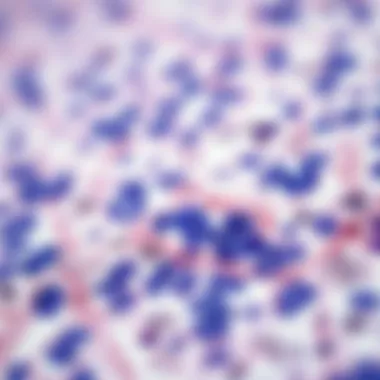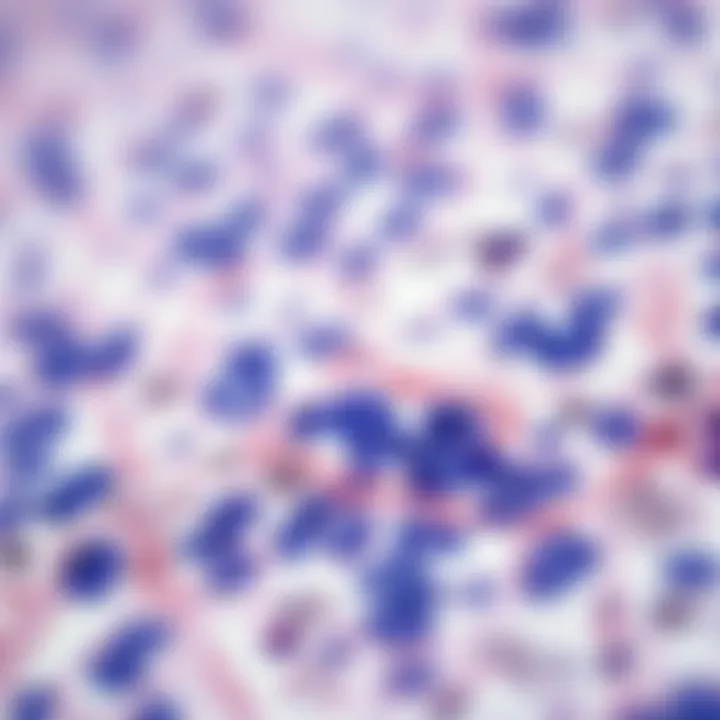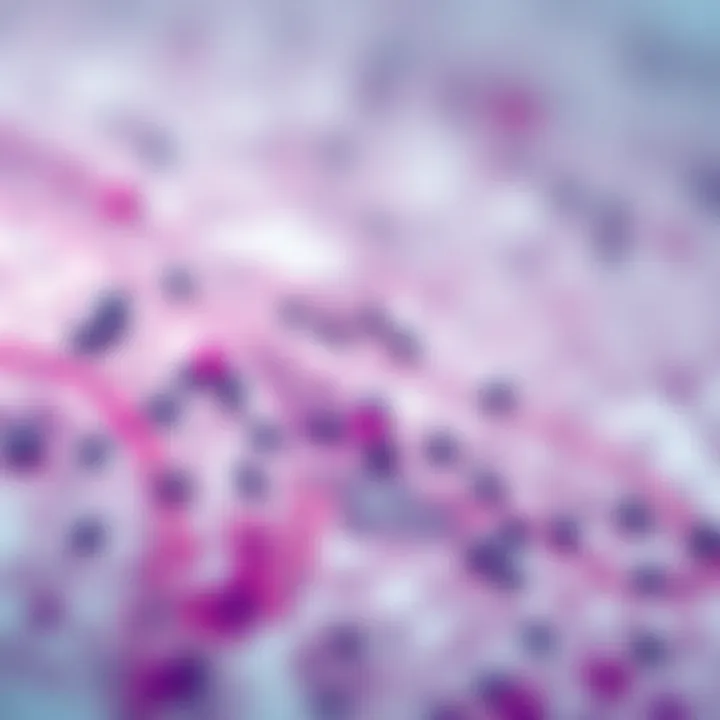Practical Applications of Immunohistochemistry in Medicine


Intro
Immunohistochemistry (IHC) stands at the crossroads of innovation in biomedical research and clinical diagnostics. It allows scientists and healthcare professionals to visualize specific proteins in tissue sections, illuminating crucial insights into various diseases and biological processes. IHC not only reveals the presence of particular markers but also assists in diagnosing conditions ranging from cancers to autoimmune disorders. In this narrative, we dive into its practical applications through rich case studies and examples, aiming to enhance understanding of this powerful tool.
Research Overview
Summary of Key Findings
The exploration of immunohistochemistry leads to significant discoveries. Some of the notable findings include:
- Emergence of biomarkers in treating cancers, improving precision medicine approaches.
- Utility in distinguishing between types of leukemia; a pivotal factor in treatment choices.
- Contributions to understanding neurodegenerative diseases by identifying pathological features.
These findings highlight the diverse capabilities of IHC and its profound impact on patient care.
Importance of the Research
The application of IHC is far-reaching. As it becomes a fundamental technique in research laboratories and hospitals, its importance is two-fold:
- Enhancing Diagnostic Accuracy: Accurate identification of proteins aids in precise diagnosis, which is essential for effective treatment.
- Driving Research Forward: Each case study not only adds knowledge to the scientific community but sparks further inquiry into potential therapeutic targets.
"Immunohistochemistry is not just a technique; it's a bridge to understanding complex biological systems and advancing healthcare."
Methodology
Study Design
Research involving IHC typically employs a range of study designs:
- Cross-sectional studies to capture a snapshot of biomarker expression across populations of tissue samples.
- Longitudinal studies to observe changes in protein expression over treatment time.
- Case-control studies to compare markers between affected and healthy individuals.
Data Collection Techniques
The data collection phase involves meticulous steps, ensuring that findings are robust and reproducible:
- Sample Preparation: Proper fixation and embedding of tissue samples are critical. Paraffin-embedding is one common direction, ensuring morphological preservation.
- Antibody Selection: The choice of antibodies is pivotal. Reactivity and specificity are scrutinized diligently.
- Detection Methods: Techniques like chromogenic detection or fluorescent staining provide clarity in visualizing targets.
- Image Analysis: The advent of digital pathology allows for enhanced quantitative analysis, contributing to data accuracy.
Overall, the methodology employed in IHC studies underscores a rigorous approach, ensuring reliability.
As we continue to delve deeper into practical examples and rich case studies, the transformative power of immunohistochemistry becomes evident, making it an invaluable component in the realms of both research and diagnostics.
Intro to Immunohistochemistry
Immunohistochemistry (IHC) serves as a cornerstone of modern diagnostic pathology and biomedical research, transforming how clinicians and researchers visualize cellular components. By leveraging the specificity of antibodies, IHC allows for the precise localization of antigens within tissue specimens. This technique goes beyond mere visualization; it enables the intricate dissection of tissue architecture and elucidation of disease mechanisms.
The importance of IHC cannot be overstated. It's through this technique that we can differentiate between various types of cells and tissues based on specific markers. This plays a significant role not just in diagnosing diseases but also in tailoring treatments to individual patients. As the landscape of healthcare shifts towards personalized medicine, IHC stands tall as a tool that aids not only in understanding but also in treating myriad conditions. The meticulous nature of IHC procedures oftentimes translates to better patient outcomes.
However, delving into IHC is more than skin deep. It brings forth considerations regarding antibody selection, potential cross-reactivity, and technical mastery. The robustness of IHC also hinges on the quality of tissue fixation and processing. Without meticulous preparation, the results can yield misleading interpretations that might hinder diagnosis. Hence, a deep dive into IHC methodologies is not just necessary; it's imperative for anyone looking to harness its full potential.
The following sections will shed light on what IHC is in its essence, providing clarity and a historical backdrop that underpins its current applications. Better understanding IHC equips professionals with the knowledge to navigate its complexities.
Defining Immunohistochemistry
In simple terms, immunohistochemistry refers to a technique used to detect specific proteins in cells within tissue sections. This is done by using antibodies that are linked to a visual marker. When these antibodies bind to their target antigens, they can be visualized under a microscope—providing a clear picture of cellular activity, pathology, and even biomarker status.
Immunohistochemistry is particularly valuable in identifying conditions like cancer. For instance, testing for hormone receptors in breast cancer patients can guide treatment strategies. The specificity of IHC allows for more than just identifying whether a disease is present; it can also impart information regarding the stage, grade, and potential therapeutic targets.
Historical Context and Evolution
The journey of immunohistochemistry began over a century ago with the early techniques of staining tissue. Back in the 1940s, researchers laid the groundwork by applying labeled antibodies to tissue sections, leading to rudimentary applications in understanding cell functionality. Fast forward to the 1980s, and we saw the introduction of various antibody labeling techniques that significantly improved detection sensitivity and specificity.
The evolution of IHC is a reflection of advances in both technology and biology. From the chemistries involved in developing antibodies to the digital imaging technologies that enhance visualization, IHC has matured into a cornerstone of diagnostic and therapeutic innovation. The introduction of multiplexing strategies allows for simultaneous detection of multiple antigens, enriching the potential insight that researchers can gain from a single tissue section.
Principles of Immunohistochemistry
Understanding the principles of immunohistochemistry (IHC) is fundamental for grasping its applications in both research and clinical settings. At its core, IHC relies on the specific binding of antibodies to target antigens in tissue sections. This specificity is what allows for the precise identification of proteins related to certain diseases, making it an invaluable tool for diagnosing various conditions, particularly cancers.
The importance of knowing the basic mechanisms cannot be overstated. For instance, familiarity with how antibodies interact with their targets helps researchers design better experiments and interpret results effectively. Moreover, awareness of the types of antibodies used can lead to more targeted approaches in both experimentation and treatment modalities.
Additionally, raising considerations about the protocols is crucial. The reliability of IHC outcomes is highly affected by the choices made in sample preparation, antibodies selection, and detection methods. This highlights the need for meticulous planning and execution in IHC studies, ensuring reproducibility and accuracy of results.


Basic Mechanisms of Antibody Binding
The primary action of IHC hinges on antibody binding to specific antigens within tissues. When an antibody binds to an antigen, it forms a compound that signals the presence of a molecule of interest. This process is akin to a key fitting into a lock; only the correctly shaped antibody can bind to its corresponding antigen. This specificity is a game-changer in diagnostics.
In practice, the binding takes place after the tissue has been prepared and fixed on glass slides. Antigen retrieval methods might be employed to unmask buried antigens, which strengthens the binding affinity and overall signal.
Each of these binding reactions can vary in strength, depending on the affinity between the antibody and antigen, as well as the conditions under which binding happens. With careful attention to these details, clinicians and researchers can glean significant insights from their samples.
Types of Antibodies Used in IHC
Antibodies used in IHC essentially fall into two broad categories: polyclonal and monoclonal.
- Polyclonal antibodies are derived from many different B cell lineages. This results in a mixture of antibodies that can recognize multiple epitopes on a single antigen. The advantage of using polyclonal antibodies lies in their ability to detect a broader range of protein variants. However, they may also introduce variability since the composition can change between batches.
- Monoclonal antibodies are made by identical immune cells that are clones of a unique parent cell. They have a single specificity to one epitope, which leads to greater consistency and reduced background noise in assay results. This can be particularly beneficial in applications requiring precise quantification of proteins.
Visualization Techniques in IHC
Visualization is a critical component in IHC, determining how the presence of target antigens is observed. Two commonly used techniques are fluorescent labeling and chromogenic detection.
Fluorescent Labeling
Fluorescent labeling employs fluorochromes attached to antibodies, allowing for the visualization of specific structures under a fluorescence microscope. This method is particularly advantageous due to its ability to depict multiple targets within the same sample using distinct fluorophores. The key characteristic that sets fluorescent labeling apart is its sensitivity; it can detect low levels of antigens that other methods may miss.
However, there are caveats. The signal generated can fade quickly, in a phenomenon known as photobleaching, which might limit the time available for analysis. Despite this, its popularity remains high in the field due to the multiplexing capabilities enabling complex cellular interactions to be studied in detail.
Chromogenic Detection
Chromogenic detection, in contrast, relies on enzymatic reactions that produce a colored precipitate at the site of antigen-antibody interaction. This technique is favored for its simplicity and ease of interpretation. The key characteristic of chromogenic detection is its visual clarity, as results can often be evaluated with standard light microscopy.
One unique feature of chromogenic detection is its permanence; color development maintains stability, allowing for further analysis even days after the initial staining. However, it may fall short in detecting low-abundance proteins compared to fluorescent methods, indicating that careful consideration is needed when choosing a visualization technique.
In summary, mastering the principles of antibody binding, understanding antibody types, and selecting the right visualization technique are all critical for the effective application of IHC in biomedical research and clinical diagnostics.
Methodologies in Immunohistochemistry
The methodologies employed in immunohistochemistry (IHC) are crucial for obtaining reliable and reproducible results. The importance of these methodologies can't be overstated, as they form the backbone of the IHC process. Each step is meticulously designed to ensure that specific proteins in tissue samples are accurately identified and visualized. By honing in on these methodologies, we can better understand their contributions to both basic research and clinical diagnostics.
Different methodologies have their unique characteristics and benefits. For instance, how tissue samples are prepared can significantly affect the quality of the results. Moreover, the protocols developed within these frameworks guide the application of IHC in diverse biomedical settings. Overall, a well-structured methodology promotes clarity and consistency in research outcomes, which, by extension, leads to better healthcare solutions.
Sample Preparation Techniques
Sample preparation techniques are not just the beginning of the IHC process; they are fundamental for ensuring the integrity and interpretability of the resultant data. It’s imperative to grasp these methods, as they can influence the binding of antibodies to antigens, impacting the entire experiment.
Tissue Fixation Methods
Tissue fixation methods are essential in preserving cellular structures and proteins in their natural state. There are several approaches to fixation, but formalin fixation is a commonly chosen method due to its effectiveness in preserving tissue morphology while retaining antigenicity, which is the ability of the tissue to react with antibodies.
- One key characteristic of formalin fixation is its ability to technically preserve most cellular components, thus ensuring reliable results in later IHC analysis.
- The unique feature of this method is its relatively easy application and cost-effectiveness. Its widespread use in laboratories across the globe emphasizes its clinical relevance.
However, the disadvantages include potential epitope masking, where certain protein structures may become inaccessible to antibodies, complicating interpretation. This can lead to misdiagnosis or inconclusive results, thus awareness of these shortcomings is vital.
Embedding and Sectioning
After fixation, embedding and sectioning are the next steps that prepare the tissue samples for microscopic examination. Embedding involves encasing the tissue in a medium like paraffin wax, allowing for thin slices to be made without losing structural integrity.
- A core feature of embedding is how it provides stability to samples, making them easier to handle and section.
- The unique advantage of paraffin embedding is its compatibility with various staining techniques, including IHC. This method allows for the preservation of cellular architecture, enabling clear visualization of antigenic targets under the microscope.
Nevertheless, one must consider the possible delays introduced during the embedding and sectioning phases. Inadequate sectioning techniques might lead to uneven slices, which can affect staining quality and overall results.
Protocol Development for IHC
Developing a robust protocol for IHC is pivotal for the success of the experiment. This step entails establishing a sequence of actions to ensure reproducibility and accuracy in results. Key elements include the choice of antibody, the dilutions used, and the timing for each component involved.
A good protocol must also account for factors like tissue type, anticipated protein levels, and available visualization techniques. Continuous refinement of protocols—based on previous findings and technological advancements—can further enhance the effectiveness of immunohistochemistry in various research applications.
In summary, understanding the methodologies in IHC serves as a foundation for both experimental design and data analysis. The techniques applied during sample preparation are critical, while protocol development ensures that these methodologies are executed effectively, paving the way for advancements in biomedical diagnostics.
Common Applications of Immunohistochemistry
Immunohistochemistry (IHC) plays a crucial role in various medical and research fields, serving as a bridge between histopathology and molecular biology. Its ability to highlight specific proteins within tissue sections significantly enhances our understanding of both normal biological processes and disease mechanisms. This section delves into three prominent applications of IHC, showcasing its immense value in oncology, infectious disease identification, and neuropathology. By examining these applications, we will highlight the impact of IHC on diagnostics and therapeutic strategies.


Oncology: IHC in Cancer Diagnosis
In the realm of oncology, IHC stands out as a powerful tool for diagnosing and classifying tumors. The ability to detect specific tumor markers—such as estrogen and progesterone receptors in breast cancer—allows pathologists to categorize tumors and tailor treatment options accordingly. This targeted approach is invaluable, particularly when considering therapies like hormonal treatments.
For instance, in a breast cancer case, if a patient’s tumor test shows positive for estrogen receptors, oncologists may recommend therapies that block estrogen production or its effects. Conversely, a negative result can steer clinicians toward alternative options.
"A definitive IHC diagnosis is often the first step towards personalized treatment plans in cancer care."
The procedure involves carefully staining tissue samples to identify the presence or absence of particular antigens, providing clarity on tumor characteristics. Furthermore, IHC can distinguish between types of lymphomas and other malignancies, enhancing diagnostic accuracy.
Infectious Diseases: Identifying Pathogens
IHC is also instrumental in the rapid identification of infectious agents within tissue samples. It can detect bacteria, viruses, fungi, and parasites, making it a cornerstone for diagnosing various infectious diseases. For example, studying an infected tissue sample from a patient suffering from tuberculosis can reveal the presence of Mycobacterium tuberculosis through specific antibodies.
In such cases, IHC not only assists in identifying the pathogen but also offers insights into the immune response elicited by the infection. This dual capability is essential for tailoring appropriate treatments, as well as for understanding disease progression.
Neuropathology: Studying Neurodegenerative Diseases
In neuropathology, IHC is used to explore the intricate biology of neurodegenerative disorders. It helps in identifying specific protein accumulations, such as tau and beta-amyloid, that are hallmarks of diseases like Alzheimer’s. By staining brain sections, researchers can pinpoint where these proteins accumulate, providing clues that help in understanding the disease's pathophysiology.
Furthermore, this method allows for the differentiation between various forms of dementia, ensuring that patients receive the most accurate diagnoses. For example, varying patterns of amyloid deposition can indicate different stages and types of Alzheimer’s disease.
Case Studies Illustrating IHC Applications
Immunohistochemistry (IHC) stands as a pioneering tool in modern diagnostics, and its applications are brought to life through case studies that illustrate its significance. These real-world examples not only highlight IHC's technical prowess but also underscore the transformative impact this technique has on patient care. In the sections that follow, we will delve into three pertinent case studies focusing on breast cancer, lymphoma, and Alzheimer’s disease. Each study portrays a unique facet of IHC, demonstrating its invaluable role in enhancing diagnostic accuracy and facilitating tailored treatments.
Breast Cancer: Hormone Receptor Testing
In the realm of breast cancer, hormone receptor testing plays a critical role in determining a patient’s treatment strategy. Through the application of IHC, oncologists can evaluate the presence of estrogen receptors (ER) and progesterone receptors (PR) on tumor cells. These markers guide the therapeutic approach, directing patients toward hormone therapies that target these receptors, ultimately enhancing prognosis and survival rates.
The process begins with the collection of a breast cancer tissue sample. Following proper fixation and sectioning, IHC techniques are employed to bind specific antibodies that recognize ER and PR proteins. This enables the visualization of receptor expression under a microscope. The mere identification of these receptors can make a world of difference. For instance, a patient with ER-positive cancer may benefit from medications such as tamoxifen or aromatase inhibitors, while those without receptor expression may require alternative therapies.
Benefits of Hormone Receptor Testing
- Personalized Treatment Plans: Tailors therapies to individual patient needs.
- Improved Outcomes: Increases the likelihood of favorable treatment responses.
- Informed Prognostic Decisions: Helps in predicting recurrence risks.
Lymphoma Diagnosis: Histological Classification
Lymphomas, which represent a diverse group of blood cancers, have their accurate classification made possible through the application of IHC. When faced with a suspected case of lymphoma, pathologists utilize IHC to differentiate between various subtypes of these malignancies. For example, distinguishing between Hodgkin lymphoma and non-Hodgkin lymphoma can significantly alter treatment protocols and patient management.
In practice, tissue biopsies are stained with a panel of antibodies specific to proteins that characterize different lymphoma types. For instance, the presence of CD30 and Reed-Sternberg cells can confirm Hodgkin lymphoma, whereas the expression of B-cell markers like CD19 or CD20 indicates non-Hodgkin lymphoma. This specificity is crucial, as it dictates not only the therapeutic approach but also prognosis.
Considerations in Lymphoma Classification
- Diverse Presentation: Lymphoma may present in various histological forms, necessitating careful evaluation.
- Accurate Biomarker Identification: Required for a definitive diagnosis.
- Therapeutic Implications: Aids in selecting appropriate chemotherapy or targeted therapies.
Alzheimer's Disease: Amyloid Plaque Detection
The diagnosis of Alzheimer’s disease often hinges on the detection of amyloid plaques within brain tissue, with IHC proving essential in this endeavor. By applying specific antibodies against beta-amyloid peptides, researchers and clinicians can reveal the presence of these neurotoxic plaques in post-mortem brain samples. This not only furthers our understanding of Alzheimer’s pathology but also supports the development of potential therapeutic strategies.
In a typical scenario, brain tissue is processed and stained for beta-amyloid. The visualization of plaques under a microscope allows for the examination of plaque density, distribution, and relationship with other pathological features. Understanding these dynamics can lead to insights into cognitive decline and symptomatology, fostering a more nuanced approach to patient care.
Importance of Plaque Detection
- Identifying Early Markers: Aids in recognizing Alzheimer’s disease at its onset.
- Research Advancements: Supports investigations into new treatments targeting amyloid pathology.
- Understanding Disease Progression: Provides insights into how amyloid presence correlates with cognitive decline.
By exploring these case studies, it becomes evident that IHC serves as a linchpin in the diagnostic landscape, bridging the gap between laboratory findings and clinical applications. This methodology does not just enhance our ability to diagnose but also paves the way for effective, personalized interventions across a spectrum of diseases.
Advancements in Immunohistochemistry Techniques
The field of immunohistochemistry is ever-evolving, marked by rapid advancements that enhance its precision, efficacy, and application scope. These innovations are crucial because they not only broaden the understanding of disease mechanisms but also improve patient outcomes through better diagnostics and targeted therapies. This section delves into two significant advancements in the field: new antibody technologies and multiplexing strategies.
New Antibody Technologies
The development of new antibody technologies constitutes a cornerstone of progress in immunohistochemistry. Traditional monoclonal antibodies have been the workhorses of the IHC landscape. However, their limitations—such as cross-reactivity and the requirement for extensive validation—have led to the exploration of more sophisticated alternatives.
Recent advancements include single-domain antibodies, also known as nanobodies, which are derived from camelids. These smaller, more stable entities possess unique properties that enable them to recognize their target antigens with remarkable specificity. The benefits of utilizing these advanced antibodies are palpable:
- Increased specificity reduces the chances of false positives.
- Better tissue penetration facilitates access to target sites within complex tissue architecture.
- Easier production and modification lead to a more adaptable tool for researchers.


Immunoassay techniques using these novel antibodies have shown promising results in various applications, such as cancer biomarker discovery and infectious disease identification. The agility of these technologies leads to a more nuanced understanding of pathologic processes, ultimately enhancing the precision of diagnostic outcomes.
Multiplexing Strategies in IHC
Multiplexing in immunohistochemistry refers to the concurrent detection of multiple antigens within a single tissue section. This approach significantly boosts the amount of information gleaned from each sample, offering a more comprehensive view of the tissue's biological landscape. The integration of advanced imaging techniques combined with multiplexing strategies facilitates a deeper dive into cellular interactions and microenvironments.
Key aspects of multiplexing strategies include:
- Simultaneous Detection: Researchers can visualize various antigens in one go, aiding in comparing expression levels across myriad conditions.
- Spatial Context: Understanding the localization of protein expression within tissue structures provides critical insights into disease mechanisms.
- Data-Rich Analysis: Advanced imaging and computational tools allow the analysis of vast datasets arising from multiplexed assays, yielding robust conclusions.
However, multiplexing also presents its own challenges. It necessitates meticulous validation processes and the development of sophisticated imaging systems that can accurately differentiate signals from various antibodies simultaneous. Nevertheless, the potential benefits overshadow these hurdles, as the depth of insight gleaned from multiplexing can drive groundbreaking discoveries in fields such as oncology and autoimmune diseases.
"Adopting innovative antibody technologies and multiplexing strategies in immunohistochemistry fundamentally transforms our approach to diagnostics and customized treatment plans."
Moving forward, the continued refinement of these techniques promises to unlock even more potential, shaping the future of research and clinical practices alike. Combining new technologies with progressive analysis frameworks enhances the overall understanding of complex diseases, thereby paving the way for advancements in precision medicine.
Challenges and Limitations of Immunohistochemistry
Immunohistochemistry (IHC) stands as a cornerstone in the realm of biomedical research and clinical diagnostics. Yet, like any scientific method, it is not without its hurdles and drawbacks. Understanding these challenges is paramount for students, researchers, educators, and professionals who rely on IHC for accurate, actionable insights about biological tissues. The significance of exploring these limitations lies in developing best practices that may help mitigate them, ultimately enhancing the efficacy of the technique.
Technical Difficulties in IHC Protocols
Implementing IHC involves a multitude of technical steps, and each one presents its unique set of challenges. The intricacies of sample preparation, from tissue fixation methods to embedding and sectioning, can lead to inconsistencies in staining results. A few common technical difficulties include:
- Tissue Fixation Errors: Incorrect fixation techniques can damage antigens, rendering them undetectable. For instance, using formalin instead of paraformaldehyde might lead to excessive cross-linking, which can mask the epitopes targeted by antibodies.
- Epithelial Tissue Challenges: In epithelial tissues, the varied morphology and depth of penetration of antibodies can produce background staining and unnecessary noise in results. This often complicates the interpretation, especially in cancers where the localization of antigen expression is critical.
- Inconsistent Antibody Performance: Not all antibodies are created equal. Variability in batch production can result in inconsistent staining, making it crucial to validate each antibody for each specific application before use.
These technical difficulties shine a light on the need for rigorous protocol evaluations to ensure reproducibility and reliability in results.
Interpretation Ambiguities in Results
Even when all technical protocols are followed to the letter, the interpretation of IHC results can remain nebulous. Ambiguities in interpretation arise from several aspects:
- Complexity of Tissue Architecture: The architecture of tissues is intricate. Different cell types within a single tissue can express different levels of the same antigen, creating a gradient of expression. This can lead to misinterpretation, particularly if the observer is untrained or rushed.
- False Positives and Negatives: Factors influencing specificity and sensitivity during antibody binding can lead to false results. Antigen cross-reactivity can cause false positives, while poorly optimized protocols may yield false negatives, potentially skewing diagnostic conclusions considerably.
- Reproducibility of Results: Variability in technique and interpretation means that results obtained by one researcher might not be replicated by another. This becomes particularly important in clinical settings where diagnostic decisions hinge on the reliability of the results.
In sum, while immunohistochemistry remains a powerful tool for investigation and diagnosis, the challenges it presents cannot be overlooked. Awareness of these limitations enables professionals in the field to improve their protocols, leading to more accurate and reliable outcomes. Keeping up with the latest advancements and engaging in continual education is essential for overcoming these hurdles.
For more insights into IHC, you might also find the following resources useful:
- Wikipedia: Immunohistochemistry
- National Institutes of Health
- University of California, San Francisco: Education Resources
- ScienceDirect
Future Perspectives of Immunohistochemistry
The future of immunohistochemistry (IHC) holds a wealth of potential that could reshape the landscape of biomedical research and clinical practice. As we look ahead, several key elements emerge that underscore the relevance and importance of IHC in advancing scientific understanding and improving patient care.
One critical aspect is the integration of IHC with genomics. This synthesis can enhance the precision of diagnostic processes. By correlating histological findings with genetic information, researchers can uncover the molecular underpinnings of diseases, leading to better-targeted therapies. When IHC is used alongside genomic data, it can facilitate the identification of specific biomarkers, allowing for a more nuanced approach to patient management. For example, identifying unique protein expressions in tumors can guide oncologists in selecting the most appropriate treatment plans tailored to the individual's genetic profile.
Integrative Approaches with Genomics
Integrative approaches that combine immunohistochemistry with genomic data are a promising avenue for future research. By embedding IHC within the broader context of genomics, scientists can leverage comprehensive datasets to derive deeper insights. A clear example of this lies in the study of cancer biology. In breast cancer, for instance, integrating IHC results that highlight hormone receptor expression with genomic profiling data enables researchers to classify tumors more accurately. This approach ultimately assists in determining prognosis and guiding therapeutic decisions.
"Linking diagnosis with genomics not only enhances our understanding of disease mechanisms but also paves the way for innovation in personalized therapy."
This synergy between IHC and genomics does not merely stop at cancer diagnostics. It extends to infectious diseases and neurodegenerative disorders as well. With ongoing advancements in next-generation sequencing technologies, the potential for high-throughput analyses makes this integrated approach increasingly feasible, thereby opening doors to expansive research possibilities.
Personalized Medicine: The Role of IHC
Another pivotal aspect of the future of IHC is its crucial role in the realm of personalized medicine. Personalized medicine aims to tailor treatment strategies based on the individual's distinct genetic makeup, lifestyle, and environmental factors. IHC serves as an essential tool in this paradigm by providing valuable information about how a patient's disease may respond to specific treatments based on the expression of various biomarkers.
For instance, in oncology, the determination of protein expressions such as HER2 or PD-L1 through IHC can significantly influence treatment plans. Patients diagnosed with HER2-positive breast cancer often respond dramatically to targeted therapies such as trastuzumab. Similarly, assessing PD-L1 levels helps identify candidates who are likely to benefit from immunotherapy. In such cases, IHC not only aids in diagnosis but also plays a decisive role in treatment selection, further emphasizing the shift toward a more individualized therapeutic approach.
Ending
In wrapping up our discussion on immunohistochemistry (IHC), it’s important to recognize how this technique serves as a vital cornerstone in both research and clinical diagnostics. As we’ve explored, IHC bridges the gap between basic science and practical applications, facilitating a deeper understanding of cellular and tissue behaviors in various pathological contexts.
The significance of IHC cannot be overstated. It equips researchers and clinicians with the ability to visualize specific proteins within tissue samples, providing critical insights into disease mechanisms, treatment responses, and prognostic indicators. This is especially true in fields such as oncology, where determining the presence of hormone receptors can steer clinical decisions.
Summarizing Key Takeaways
- Versatility of IHC: Immunohistochemistry is a multifaceted tool, applicable across a broad spectrum of diseases, from cancer to neurodegenerative disorders. It offers unique insights into the protein expression profiles that underpin these conditions.
- Enhancing Diagnostic Accuracy: IHC aids in clarifying ambiguous results that might arise from histopathological examinations alone, ensuring that diagnoses are both timely and accurate.
- Technological Advancements: The continual development of new antibody technologies and multiplexing strategies enhances the ability of IHC to provide more detailed and nuanced results. This ensures that clinicians and researchers remain at the cutting edge of medical science.
- Integration with Genomics: IHC's role in personalized medicine is becoming more evident. By correlating protein expression data with genomic information, IHC contributes to a more tailored approach in treatment planning, ultimately improving patient outcomes.
- Ongoing Challenges: Recognizing the technical difficulties and interpretation ambiguities inherent in IHC is essential. Ongoing research and refinement of methodologies are crucial to overcoming these hurdles.
The exploration of practical applications and associated case studies illustrates not only the power of immunohistochemistry but also its growing relevance as healthcare evolves. As we move forward, the dialogue surrounding IHC will only expand, revealing new opportunities to harness this technique for innovative medical solutions.
"Immunohistochemistry remains a key tool in the quest for better diagnostics and therapeutics, continually evolving to meet the needs of today’s complex diseases."
To further your understanding of IHC and its importance in biomedical research and diagnostics, consider visiting NIH or Nature Reviews.



